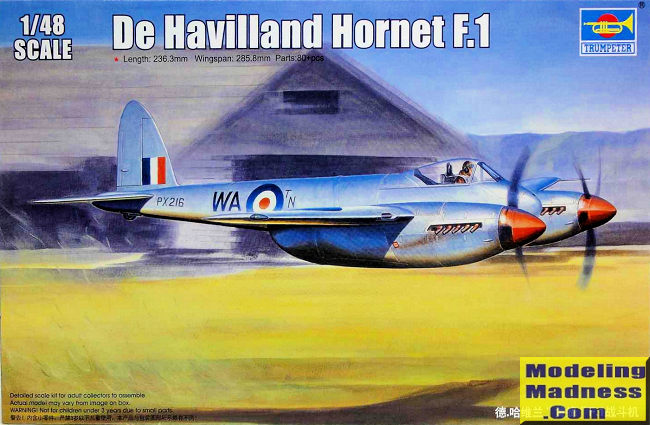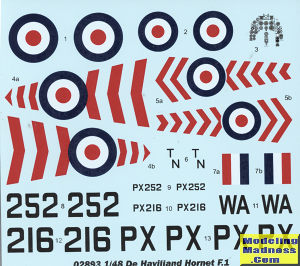
Trumpeter 1/48 deHavilland Hornet F.1
| KIT #: | 02893 |
| PRICE: | $ |
| DECALS: | Two options |
| REVIEWER: | Scott Van Aken |
| NOTES: | 2014 release |

| HISTORY |
The de Havilland DH.103 Hornet was a twin-piston engined fighter aircraft developed by de Havilland. It further exploited the wooden construction techniques that had been pioneered by the earlier de Havilland Mosquito. Development of the Hornet had started during the Second World War as a private venture, an aim for the aircraft was to conduct long range fighter operations in the Pacific Theatre against the Empire of Japan. However, the war ended before the Hornet reached operational squadron status.
The Hornet entered service with RAF Fighter Command where it equipped several day fighter units and was commonly stationed in the British mainland. It saw combat in the Far East, being used successfully as a strike fighter as part of the British military action taken during the Malayan Emergency. A navalised carrier-capable version, the Sea Hornet, had been envisioned early on and was procured by the Fleet Air Arm of the Royal Navy.
| THE KIT |
 Trumpeter's kit is up to all modern requirements in terms of the detailing
provided. Based on earlier experience with their kits, I also expect the fit to
be quite good. Trumpeter has offered at least three boxings of this plane,
including the F.3 and the Sea Hornet. Having built the Classic Airframes Sea
Hornet F.20, I fully expect this kit to be significantly easier to assemble.
Trumpeter's kit is up to all modern requirements in terms of the detailing
provided. Based on earlier experience with their kits, I also expect the fit to
be quite good. Trumpeter has offered at least three boxings of this plane,
including the F.3 and the Sea Hornet. Having built the Classic Airframes Sea
Hornet F.20, I fully expect this kit to be significantly easier to assemble.
The kit provides a nice cockpit tub with instrument panel that is provided with a decal for those who like these. The seat is basic, but looks like what the plane carries. There is a single piece shelf to fit behind the tub and the kit provides detailed sidewalls.
Once the 'pit is trapped between the fuselage halves, the kit moves to the engine nacelles. Apparently you need to install the main gear legs when building the nacelles, but I'd test fit things to see if that can be delayed until after painting. I'm not a fan of separate prop blades, but this kit has just that feature. There are alignment pins on each of the four blades to help out.
When the wings are assembled, one then attaches them along with the
tailplanes and fin to the fuselage. These latter two items are in two pieces. As
a note, the kit sprues do include the fin for the F.3, which is pretty much the
only visual difference between the two variants so if you have aftermarket
decals, you can build this as the later version. With all those attached, then
the nacelles and canopy are glued on. The final items are the tail wheel and the
flaps, which can be modeled in the lowered position.
you have aftermarket
decals, you can build this as the later version. With all those attached, then
the nacelles and canopy are glued on. The final items are the tail wheel and the
flaps, which can be modeled in the lowered position.
Instructions are well done as usual with Trumpeter. The decals provide two options. Both are in high speed silver. One of them is the rather dull looking box art plane. The other is the more garish plane with the red arrows all over the wing and fuselage. Neither unit is identified, but the big red markings are for 65 Squadron and I'm guessing that the WA coded one is 64 squadron. The only other unit to fly the F.1 was 19 Squadron. The decals are nicely printed and should provide no issues in application.
| CONCLUSIONS |
I have always thought that the Hornet was among the top five best looking piston powered aircraft and every collection should have at least one of them in it.
| REFERENCES |
https://en.wikipedia.org/wiki/De_Havilland_Hornet
November 2018 Copyright ModelingMadness.com.
All rights reserved. Thanks to me for buying this one. If you would like your product reviewed fairly and
fairly quickly, please
contact
the editor
or see other details in the
Note to
Contributors.
Back to the Main Page
Back to the Review
Index Page
Back to the Previews Index Page